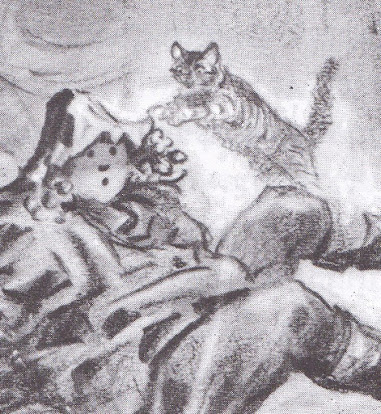The horse stories of my childhood were brilliantly illustrated by Wesley Dennis, who captured movement and even facial expressions in a way that was almost uncanny. Marguerite Henry's horse stories, which now seem terribly sentimentalized, were brought to life by Dennis's whimsy and fierceness. Misty of Chincoteague and King of the Wind would not have been the same without these works of art.
Showing posts with label Marguerite Henry. Show all posts
Showing posts with label Marguerite Henry. Show all posts
Monday, February 26, 2024
Friday, August 3, 2018
Assateague to Chincoteague: Pony Penning Day
Wild ponies swim from Assateague to Chincoteague Island, Maryland, for the annual Pony Penning Day. This event was mythologized in Marguerite Henry's children's novel, Misty of Chincoteague (with glorious, magical illustrations by Wesley Dennis). The movie made from the novel wasn't half-bad, as they used the real ponies, location, and locals.
Thursday, January 4, 2018
Grimalkin is his name
Grimalkin
My cat is such a mouser (oh dear me!)
He catches more than Towser
He sneaks along the floor, you know
And hides behind the door, and so
Grimalkin is his name!
A mouse comes up a-creeping (oh dear me!)
He thinks the cat is sleeping
He's snoring surely, but you know
His left eye isn't shut, and so
He's watching all the same!
Purr-haps you've guessed what followed (oh dear me!)
That little mouse was swallowed
I'll tell you now what happened then
Grimalkin took a nap and then
Poor Towser got the blame!
A grimalkin (also called a greymalkin) is an archaic term for a cat. The term stems from "grey" (the colour) plus "malkin", an archaic term with several meanings (a cat, a low class woman, a weakling, a mop or a name) derived from a hypocoristic form of the female name Maud. Scottish legend makes reference to the grimalkin as a faery cat that dwells in the highlands.
Nostradamus the French prophet & astrologer, 1503-1566, had a cat named Grimalkin.
A cat named Grimalkin in William Shakespeare‘s 1606 play MacBeth helped the three blind witches look into Macbeth’s future.
During the early modern period, the name grimalkin – and cats in general – became associated with the devil and witchcraft. Women tried as witches in the 16th, 17th and 18th centuries were often accused of having a familiar, frequently a grimalkin. A noted example is the familiar of one of the three witches in Macbeth. - Wikipedia
I first saw the name Grimalkin in a favorite childhood book of mine, King of the Wind by Marguerite Henry. This is a heavily fictionalized story about the Godolphin Arabian, one of the founding sires of the Thoroughbred breed. A fabulously prized Arab stallion named Sham is shipped to England from Arabia, a gift from some sultan-or-other - oh, let's get to the good part, shall we? Like most fairy tale characters, Sham loses his royal status and must endure many trials (not unlike Anna Sewell's Black Beauty, which Marguerite Henry no doubt read many times), including toiling as a humble cart-horse under the whip. Luckily the Earl of Godolphin intervenes in time, knowing a good piece of horseflesh when he sees one. In a wildly-unrealistic scene, Sham and Lady Roxana, an immaculate white mare primed to breed with the evil stallion Hobgoblin, break away from their handlers and elope. The Thoroughbred breed results.
Grimalkin is a supporting character who isn't even in the book for very long, but like most cats, he makes the best of his part and gladly accompanies Agba (the little Arab horseboy) and Sham into exile, making the best of things at Wicken Fen. The brilliant illustrator Wesley Dennis had a talent, if not genius, for conveying motion, the fluid natural movements of dogs and horses and even cats. His subjects always seemed just about to do something: Dennis knew what, and conveyed it without even having to show it.
The legendary horse-artist sketched this wee sleekit feline in the most fey, ghostlike poses, using just a few strokes of the pencil. Usually he was perched on the back or neck or rump of the hero, like so:
The complicated, twisting, braided strands of the name Grimalkin are about as weirdly mystical as anything I've seen lately. The different meanings of the word "malkin" (a cat, a low class woman, a weakling, a mop or a name) sound kind of like my autobiography. A faery cat that dwells in the Highlands, witches, familiars, Macbeth, being burned at the stake - how mystical is that? But all cats are magic. They wave their tails and walk by their wild lonesome and care not a fig what we think about them - never have, and never will.
Sunday, January 1, 2017
The art of the horse
This is just a small sampling of the magnificent "horse art" of Wesley Dennis, who illustrated all of Marguerite Henry's most famous books. He had a sense of the horse that transcended mere likeness and transformed Henry's books from ripping good stories into something magical and unforgettable. I still have my old, yellowed copy of Misty of Chincoteague, and my King of the Wind with the cover long gone. Some of the black-and-white illustrations have been coloured in with pencil crayons - surely not by me! I had three older siblings who all had their way with these books until they were handed down to me. This merely added layers of magic.
Subscribe to:
Posts (Atom)








